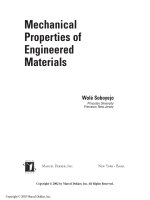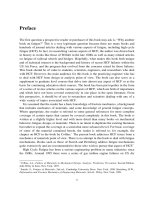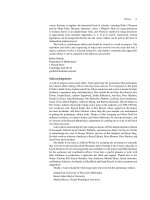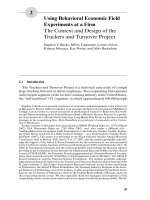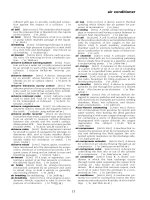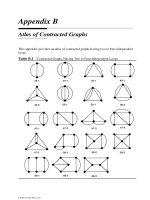Mechanical Properties of Engineered Materials 2008 Part 2 pps
Bạn đang xem bản rút gọn của tài liệu. Xem và tải ngay bản đầy đủ của tài liệu tại đây (575.14 KB, 22 trang )
1
Overview of Crystal/Defect Structure
and Mechanical Properties and
Behavior
1.1 INTRODUCTION
The mechanical behavior of materials describes the response of materials to
mechanical loads or deformation. The response can be understood in terms
of the basic effects of mechanical loads on defects or atomic motion. A
simple understanding of atomic and defect structure is, therefore, an essen-
tial prerequisite to the development of a fundamental understanding of the
mechanical behavior of materials. A brief introduction to the structure of
materials will be presented in this chapter. The treatment is intended to serve
as an introduction to those with a limited prior background in the principles
of materials science. The better prepared reader may, therefore, choose to
skim this chapter.
1.2 ATOMIC STRUCTURE
In ancient Greece, Democritus postulated that atoms are the building blocks
from which all materials are made. This was generally accepted by philoso-
phers and scientists (without proof) for centuries. However, although the
small size of the atoms was such that they could not be viewed directly with
the available instruments, Avogadro in the 16th century was able to deter-
mine that one mole of an element consists of 6:02 Â 10
23
atoms. The peri-
Copyright © 2003 Marcel Dekker, Inc.
odictableofelementswasalsodevelopedinthe19thcenturybeforethe
imagingofcrystalstructurewasmadepossibleafterthedevelopmentofx-
raytechniqueslaterthatcentury.Forthefirsttime,scientistswereableto
viewtheeffectsofatomsthathadbeenpostulatedbytheancients.
Aclearpictureofatomicstructuresoonemergedasanumberof
dedicatedscientistsstudiedtheatomicstructureofdifferenttypesofmateri-
als.First,itbecameapparentthat,inmanymaterials,theatomscanbe
groupedintounitcellsorbuildingblocksthataresomewhatakintothe
piecesinaLegoset.Thesebuildingblocksareoftencalledcrystals.
However,therearemanymaterialsinwhichnocleargroupingofatoms
intounitcellsorcrystalscanbeidentified.Atomsinsuchamorphousmate-
rialsareapparentlyrandomlydistributed,anditisdifficulttodiscernclear
groupsofatomsinsuchmaterials.Nevertheless,inamorphousandcrystal-
linematerials,mechanicalbehaviorcanonlybeunderstoodifweappreciate
thefactthattheatomswithinasolidareheldtogetherbyforcesthatare
oftenreferredtoaschemicalbonds.Thesewillbedescribedinthenext
section.
1.3CHEMICALBONDS
Twodistincttypesofchemicalbondsareknowntoexist.Strongbondsare
oftendescribedasprimarybonds,andweakerbondsaregenerallydescribed
assecondarybonds.However,bothtypesofbondsareimportant,andthey
oftenoccurtogetherinsolids.Itisparticularlyimportanttonotethatthe
weakersecondarybondsmaycontrolthemechanicalbehaviorofsome
materials,evenwhenmuchstrongerprimarybondsarepresent.Agood
exampleisthecaseofgraphite(carbon)whichconsistsofstrongprimary
bondsandweakersecondarybonds(Fig.1.1).Therelativelylowstrengthof
graphitecanbeattributedtothelowshearstressrequiredtoinducethe
slidingofstrongly(primary)bondedcarbonlayersovereachother.Such
slidingiseasybecausethebondsbetweenthesliding(primarybonded)
carbonplanesareweaksecondarybonds.
1.3.1PrimaryBonds
Primarybondsmaybeionic,covalent,ormetallicincharacter.Sincethese
arerelativelystrongbonds,primarybondsgenerallygiverisetostiffsolids.
Thedifferenttypesofprimarybondsaredescribedindetailbelow.
1.3.1.1IonicBonding
Ionic bonds occur as a result of strong electrostatic Coulomb attractive
forces between positively and negatively charged ions. The ions may be
Copyright © 2003 Marcel Dekker, Inc.
formed by the donation of electrons by a cation to an anion (Fig. 1.2). Note
that both ions achieve more stable electronic structures (complete outer
shells) by the donation or acceptance of electrons. The resulting attractive
force between the ions is given by:
F ¼À
Q
1
Q
2
r
2
ð1:1Þ
FIGURE 1.1 Schematic of the layered structure of graphite. (Adapted from
Kingery et al., 1976. Reprinted with permission from John Wiley and Sons.)
FIGURE 1.2 Schematic of an ionic bond—in this case between a sodium atom
and a chlorine atom to form sodium chloride. (Adapted from Ashby and
Jones, 1994. Reprinted with permission from Pergamon Press.)
Copyright © 2003 Marcel Dekker, Inc.
whereaisaproportionalityconstant,whichisequalto1=ð4"
0
),"
0
isthe
permitivityofthevacuum(8:5Â10
À12
F/m),Q
1
andQ
2
aretherespective
chargesofions1and2,andristheionicseparation,asshowninFig.1.2.
Typicalionicbondstrengthsarebetween40and200kcal/mol.Also,dueto
theirrelativelyhighbondstrengths,ionicallybondedmaterialshavehigh
meltingpointssinceagreaterlevelofthermalagitationisneededtoshear
theionsfromtheionicallybondedstructures.Theionicbondsarealso
nonsaturatingandnondirectional.Suchbondsarerelativelydifficultto
breakduringslipprocessesthataftercontrolplasticbehavior(irreversible
deformation).Ionicallybondedsolidsare,therefore,relativelybrittlesince
theycanonlyundergolimitedplasticity.Examplesofionicallybonded
solidsincludesodiumchlorideandotheralkalihalides,metaloxides,and
hydratedcarbonates.
1.3.1.2CovalentBonds
Anothertypeofprimarybondisthecovalentbond.Covalentbondsare
oftenfoundbetweenatomswithnearlycompleteoutershells.Theatoms
typicallyachieveamorestableelectronicstructure(lowerenergystate)by
sharingelectronsinoutershellstoformstructureswithcompletelyfilled
outershells[(Fig.1.3(a)].Theresultingbondstrengthsarebetween30and
300kcal/mol.Awiderrangeofbondstrengthsis,therefore,associatedwith
covalentbondingwhichmayresultinmolecular,linearorthree-dimensional
structures.
One-dimensionallinearcovalentbondsareformedbythesharingof
twoouterelectrons(onefromeachatom).Theseresultintheformationof
molecular structures such as Cl
2,
which is shown schematically in Figs 1.3b
and 1.3c. Long, linear, covalently bonded chains, may form between quad-
rivalentcarbonatoms,asinpolyethylene[Figs1.4(a)].Branchesmayalso
form by the attachment of other chains to the linear chain structures, as
shown in Fig. 1.4(b). Furthermore, three-dimensional covalent bonded
FIGURE 1.3 The covalent bond in a molecule of chlorine (Cl
2
) gas: (a) planetary
model; (b) electron dot schematic; (c) ‘‘bond-line’’ schematic. (Adapted from
Shackleford, 1996. Reprinted with permission from Prentice-Hall.)
Copyright © 2003 Marcel Dekker, Inc.
structures may form, as in the case of diamond [Fig. 1.4(c)] and the recently
discovered buckeyball structure [Fig. 1.4(d)].
Due to electron sharing, covalent bonds are directional in character.
Elasticity in polymers is associated with the stretching and rotation of
bonds. The chain structures may also uncurl during loading, which generally
gives rise to elastic deformation. In the case of elastomers and rubber-like
materials, the nonlinear elastic strains may be in excess of 100%. The elastic
moduli also increase with increasing temperature due to changes in entropy
that occur on bond stretching.
FIGURE 1.4 Typical covalently bonded structures: (a) three-dimensional
structure of diamond; (b) chain structure of polyethylene; (c) three-
dimensional structure of diamond; (d) buckeyball structure of C
60
. (Adapted
from Shackleford, 1996. Reprinted with permission from Prentice-Hall.)
Copyright © 2003 Marcel Dekker, Inc.
Plasticityincovalentlybondedmaterialsisassociatedwiththesliding
ofchainsconsistingofcovalentlybondedatoms(suchasthoseinpolymers)
orcovalentlybondedlayers(suchasthoseingraphite)overeachother[Figs
1.1and1.4(a)].Plasticdeformationofthree-dimensionalcovalentlybonded
structures[Figs1.4(c)and1.4(d)]isalsodifficultbecauseoftheinherent
resistanceofsuchstructurestodeformation.Furthermore,chainslidingis
restrictedinbranchedstructures[Fig.1.4(b)]sincethebranchestendto
restrictchainmotion.
1.3.1.3MetallicBonds
Metallicbondsarethethirdtypeofprimarybond.Thetheorybehind
metallicbondingisoftendescribedastheDru
¨
de–Lorenztheory.Metallic
bondscanbeunderstoodastheoveralleffectofmultipleelectrostaticattrac-
tionsbetweenpositivelychargedmetallicionsanda‘‘sea’’or‘‘gas’’of
delocalizedelectrons(electroncloud)thatsurroundthepositivelycharged
ions(Fig.1.5).ThisisillustratedschematicallyinFig.1.5.Notethatthe
outerelectronsinametalaredelocalized,i.e.,theyarefreetomovewithin
themetalliclattice.Suchelectronmovementcanbeacceleratedbytheappli-
cationofanelectricfieldoratemperaturefield.Theelectrostaticforces
betweenthepositivelychargedionsandtheseaofelectronsareverystrong.
Thesestrongelectrostaticforcesgiverisetothehighstrengthsofmetallically
bondedmaterials.
Metallicbondsarenonsaturatingandnondirectionalincharacter.
Hence,linedefectswithinmetallicallybondedlatticescanmoveatrelatively
lowstresses(belowthoserequiredtocauseatomicseparation)byslippro-
cessesatrelativelylowstresslevels.Themechanismsofslipwillbediscussed
later. These give rise to the ductility of metals, which is an important prop-
erty for machining and fabrication processes.
FIGURE 1.5 Schematic of metallic bonding. (Adapted from Ashby and Jones,
1994. Reprinted with permission from Pergamon Press.)
Copyright © 2003 Marcel Dekker, Inc.
1.3.2 Secondary Bonds
Unlike primary bonds, secondary bonds (temporary dipoles and Van der
Waals’ forces) are relatively weak bonds that are found in several materials.
Secondary bonds occur due to so-called dipole attractions that may be
temporary or permanent in nature.
1.3.2.1 Temporary Dipoles
As the electrons between two initially uncharged bonded atoms orbit their
nuclei, it is unlikely that the shared electrons will be exactly equidistant from
the two nuclei at any given moment. Hence, small electrostatic attractions
may develop between the atoms with slightly higher electron densities and
the atoms with slightly lower electron densities [Fig. 1.6(a)]. The slight
perturbations in the electrostatic charges on the atoms are often referred
to as temporary dipole attractions or Van der Waals’ forces [Fig. 1.6(a)].
However, spherical charge symmetry must be maintained over a period of
time, although asymmetric charge distributions may occur at particular
moments in time. It is also clear that a certain statistical number of these
attractions must occur over a given period.
Temporary dipole attractions result in typical bond strengths of
$ 0:24 kcal/mol. They are, therefore, much weaker than primary bonds.
FIGURE 1.6 Schematics of secondary bonds: (a) temporary dipoles/Van der
Waals’ forces; (b) hydrogen bonds in between water molecules. (Adapted
from Ashby and Jones, 1994. Reprinted with permission from Pergamon
Press.)
Copyright © 2003 Marcel Dekker, Inc.
Nevertheless,theymaybeimportantindeterminingtheactualphysical
statesofmaterials.VanderWaals’forcesarefoundbetweencovalently
bondednitrogen(N
2
)molecules.TheywerefirstproposedbyVander
Waalstoexplainthedeviationsofrealgasesfromtheidealgaslaw.They
arealsopartlyresponsibleforthecondensationandsolidificationofmole-
cularmaterials.
1.3.2.2HydrogenBonds
Hydrogenbondsareinducedasaresultofpermanentdipoleforces.Dueto
thehighelectronegativity(powertoattractelectrons)oftheoxygenatom,
thesharedelectronsinthewater(H
2
O)moleculearemorestronglyattracted
totheoxygenatomthantothehydrogenatoms.Thehydrogenatomthere-
forebecomesslightlypositivelycharged(positivedipole),whiletheoxygen
atomacquiresaslightnegativecharge(negativedipole).Permanentdipole
attractions,therefore,developbetweentheoxygenandhydrogenatoms,
givingrisetobridgingbonds,asshowninFig.1.6(b).Suchhydrogen
bondsarerelativelyweak(0.04–0.40kcal/mol).Nevertheless,theyare
requiredtokeepwaterintheliquidstateatroom-temperature.Theyalso
providetheadditionalbindingthatisneededtokeepseveralpolymersinthe
crystallinestateatroomtemperature.
1.4STRUCTUREOFSOLIDS
Thebondedatomsinasolidtypicallyremainintheirlowestenergyconfig-
urations.Inseveralsolids,however,noshort-orlong-rangeorderis
observed.Suchmaterialsareoftendescribedasamorphoussolids.
Amorphousmaterialsmaybemetals,ceramics,orpolymers.Manyare
metastable,i.e.,theymightevolveintomoreorderedstructuresonsub-
sequentthermalexposure.However,therateofstructuralevolutionmay
beveryslowduetoslowkinetics.
1.4.1Polymers
Thebuildingblocksofpolymersarecalledmers[Figs1.7(a)and1.7(b)].
These are organic molecules, each with hydrogen atoms and other elements
clustered around one or two carbon atoms. Polymers are covalently bonded
chain structures that consist of hundreds of mers that are linked together via
addition or condensation chemical reactions (usually at high temperatures
and pressures). Most polymeric structures are based on mers with covalently
bonded carbon–carbon (C
–
C) bonds. Single (C
–
C), double (C
–
–
C), and
triple (C
–
–
–
C) bonds are found in polymeric structures. Typical chains con-
tain between 100 and 1000 mers per chain. Also, most of the basic properties
Copyright © 2003 Marcel Dekker, Inc.
of polymers improve with increasing average number of mers per chain.
Polymer chains may also be cross-linked by sulfur atoms (Fig. 1.7(b)].
Such cross-linking by sulfur atoms occurs by a process known as vulcaniza-
tion, which is carried out at high temperatures and pressures. Commercial
rubber (isoprene) is made from such a process.
The spatial configurations of the polymer chains are strongly influ-
enced by the tetrahedral structure of the carbon atom [Fig. 1.7(c)]. In the
case of single C
–
C bonds, an angle of 109.58 is subtended between the
FIGURE 1.7 Examples of polymeric structures: (a) polymerization to form
poly(vinyl chloride) (C
2
H
3
Cl)
n
; (b) cross-linked structure of polyisoprene; (c)
bond angle of 109.58; (d) bond stretching and rotation within kinked and
coiled structure. (Adapted from Shackleford, 1996. Reprinted with permission
from Prentice-Hall).
Copyright © 2003 Marcel Dekker, Inc.
carbonatomandeachofthefourbondsinthetetrahedralstructure.The
resultingchainstructureswill,therefore,tendtohavekinkedandcoiled
structures,asshowninFigs1.7(d).Thebondsintetrahedralstructure
mayalsorotate,asshowninFig.1.7(d).
Mostpolymericstructuresareamorphous,i.e.,thereisnoapparent
long-orshort-rangeordertothespatialarrangementofthepolymerchains.
However,evidenceofshort-andlong-rangeorderhasbeenobservedin
somepolymers.Suchcrystallinityinpolymersisdueprimarilytothe
formationofchainfolds,asshowninFig.1.8.Chainfoldsareobserved
typicallyinlinearpolymers(thermoplastics)sincesuchlinearstructuresare
amenabletofoldingofchains.Morerigidthree-dimensionalthermoset
structuresareverydifficulttofoldintocrystallites.Hence,polymercrystal-
linityistypicallynotobservedinthermosetstructures.Also,polymerchains
withlargesidegroupsaredifficulttobendintofoldedcrystallinechains.
Ingeneral,thedeformationofpolymersiselastic(fullyreversible)
whenitisassociatedwithunkinking,uncoilingorrotationofbonds
[Fig.1.7(d)].However,polymerchainsmayslideovereachotherwhen
theappliedstressortemperaturearesufficientlylarge.Suchslidingmay
berestrictedbylargesidegroups[Fig.1.4(b)]orcross-links[Fig.1.7(b)].
Permanent, plastic, or viscous deformation of polymers is, thus, associated
with chain sliding, especially in linear (thermoplastic) polymers. As discussed
FIGURE 1.8 Schematic of amorphous and crystalline regions within long-
chain polymeric structure. (Adapted from Ashby and Jones, 1994.
Reprinted with permission from Pergamon Press.)
Copyright © 2003 Marcel Dekker, Inc.
earlier, chain sliding is relatively difficult in three-dimensional (thermoset)
polymers. Hence, thermosets are relatively rigid and brittle compared to
thermoplastics.
Long-chain polymeric materials exhibit a transition from rigid glass-
like behavior to a viscous flow behavior above a temperature that is gen-
erally referred to as the glass transition temperature, T
g
. This transition
temperature is usually associated with change in coefficient of thermal
expansion which may be determined from a plot of specific volume versus
temperature (Fig. 1.9). It is also important to note that the three-dimen-
sional structures of thermosets (rigid network polymers) generally disinte-
grate at elevated temperatures. For this reason, thermosets cannot be reused
after temperature excursions above the critical temperature levels required
for structural disintegration. However, linear polymers (thermoplastics) do
not disintegrate so readily at elevated temperatures, although they may
soften considerably above T
g
. They can thus be re-used after several ele-
vated-temperature exposures.
1.4.2 Metals and Ceramics
Metals are usually solid elements in the first three groups of the periodic
table. They contain de-localized outer electrons that are free to ‘‘swim
about’’ when an electric field is applied, as discussed in Sect. 1.3.1.3 on
metallic bonding. Ceramics are compounds formed between metals and
FIGURE 1.9 Schematic illustration of ductile-to-brittle transition in plot of
specific volume versus temperature (Adapted from Shackleford, 1996.
Reprinted with permission from Prentice-Hall.)
Copyright © 2003 Marcel Dekker, Inc.
nonmetals.Ceramicsmayhaveionic,covalent,ormixedionicandcovalent
bonds.Therelativelyhighcompressivestrengthsofmostceramicsmayalso
beattributedlargelytostrongionicand/orcovalentbonds.Unfortunately,
however,mostceramicsarebrittleduetotheirinabilitytoaccommodate
strainsinthepresenceofcracktips(especiallyundertensileloadingwhere
crackstendtoopenup).
Metalsandceramicsusuallyhavelong-range,ordered,crystalline
structures.However,amorphousstructuresmayalsoformundercertain
processingconditions.Inthecaseofcrystallinemetallicandceramicmate-
rials,theatomswithineachcrystalallhavethesameorientation.Acrystal-
linelattice,consistingofregularrepeatedunits(somewhatakintoLego
buildingblocksinachild’splaykit)inaregularlattice,isobserved.Each
repeatedunitisusuallyreferredtoasaunitcell,andtheunitcellisgenerally
chosentohighlightthesymmetryofthecrystal.
Anexampleofatwo-dimensionalunitcellisshowninFig.1.10(a).
This illustrates the two-dimensional layered structure of graphite which is
one of the allotropes of carbon. Note that each carbon atom in the graphite
structure is surrounded by three near neighbors. However, the orientations
of the near neighbors to atoms A and B are different. Atoms similar to A are
found at N and Q, and atoms similar to B are found at M and P. In any
case, we may arbitrarily choose a unit cell, e.g., OXAY, that can be moved
to various positions until we fill the space with identical units. If the repeti-
tion of the unit is understood to occur automatically, only one unit must be
described to describe fully the crystal.
The unit chosen must also be a parallelogram in two dimensions, or a
parallelepiped in three dimensions. It is referred to as a mesh or a net in two
dimensions, or a unit cell in three dimensions. Since atoms at the corner of
the mesh or unit cell may be shared by adjacent nets/unit cells, the total
number of atoms in a unit cell may depend on the sum of the fractions of
atoms that are present with an arbitrarily selected unit cell. For example, the
mesh shown in Fig. 1.10(a) contains (4 Â 1=4) 1 atom. The three-dim ensional
parallelepiped also contains (8 Â 1=8) 1 atom per unit cell [Fig. 1.10(b)].
It is also important to note here that the origin of the unit cell is at the
corner of the unit cell [Fig. 1.10(c)]. The sides of the unit parallelepiped also
correspond to the cartesian x, y, z axes, and the angles , , are the axial
angles. The arrangement of atoms may therefore be described by a three-
dimensional grid of straight lines that divide the space into parallelepipeds
that are equal in size. The intersection of lines is called a space lattice, and
the crystal is constructed by stacking up the unit cells in a manner somewhat
analogous the stacking of Lego pieces [Fig. 1.10(c)].
The most common crystalline lattices in metallic materials are the
body-centered cubic, face-centered cubic, hexagonal closed-packed and
Copyright © 2003 Marcel Dekker, Inc.
thesimplecubicstructures.TheseareshownschematicallyinFig.1.11.The
hexagonalandcubicstructurescanbeconstructedbythestackingof
individualcrystals,asshownin[Figs1.12(aandb)].Notethatthehexago-
nalclosedpacked(h.c.p.)haveanABABABstackingsequence,whilethe
FIGURE1.10Schematicsofpossibleunitcells.(a)Two-dimensionalstructure
of graphite. (From Kelly and Groves, 1970.) (b) Parrellepiped/unit cell showing
axes and angles. (c) A space lattice. (Adapted from Hull and Bacon, 1984.
Reprinted with permission from Pergamon Press.)
Copyright © 2003 Marcel Dekker, Inc.
FIGURE 1.11 Schematics of 14 Bravais lattices. (Adapted from Shackleford,
1996. Reprinted with permission from Prentice-Hall.)
FIGURE 1.12 Schematic of stacking sequence in closed packed lattices:
(a) hexagonal closed packed structure; (b) face-centered cubic structure.
(Adapted from Hull and Bacon, 1984. Reprinted with permission from
Pergamon Press.)
Copyright © 2003 Marcel Dekker, Inc.
(f.c.c.)structurehasanABCABCstackingsequence.Also,bothf.c.c.and
h.c.p.structuresareclosedpackedstructureswithseveralclosed-packed
planesonwhichplasticflowcanoccur.
Crystallineceramicmaterialsgenerallyhavemorecomplexstructures
withlowersymmetry.Ingeneral,however,14Bravaislatticesarepossiblein
crystallinematerials,asshowninFig.1.11.Notetheincreasingcomplexity
andthereductioninsymmetryoftheBravaislatticesthatdonothavecubic
orhexagonalcrystalstructures.Crystallinecermicshavelesssymmetric
structures.Thelossofsymmetryispartlyresponsiblefortherelatively
brittlebehaviorthatistypicallyobservedinceramicsystems.Thiswillbe
discussedlater.FurtherdiscussiononBravaislatticescanbefoundinany
standardtextoncrystallography.
1.4.3Intermetallics
Intermetallicsarecompoundsformedbetweendifferentmetals.Thebonds
areoftenmixedmetallicandcovalentbonds.However,mostintermetallics
areoftenmetallic-likeincharacter.Intermetallicsare,therefore,generally
strong,butbrittleasaresultoftheirmixedbondingcharacter.Theyalso
havepredominantlynoncubic(nonsymmetric)structures.Nevertheless,
(relatively)lightweight,high-temperatureintermetallicssuchasgamma-
basedtitaniumaluminides(TiAl)andniobiumaluminides(Nb
3
Al)areof
commercialinterest,especiallyintheaerospaceindustrywheretheyare
beingconsideredaspossiblereplacementsforheaviernickel-,iron-,or
cobalt-basesuperalloys,themselvesoftencontainingintermetallics(Fig.
1.13).Somerecentimprovementsinthebalanceofpropertiesofthesemate-
rialssuggeststhattheymaybeusedinthenextgenerationofaircrafttur-
bines.
1.4.4Semiconductors
These are typically group IV elements (or their compounds) that have four
outer electrons. The outer electrons can be excited into the conduction
bands by application of electric fields. Electrical conductivity in semicon-
ductors occurs either by electron or hole movement [Figs 1.14(a) and
1.14(b)]. In recent years, semiconductor packages have been applied in sev-
eral electronic devices consisting of layered configurations of semiconduc-
tors deposited on metallic substrates within polymeric or ceramic
encapsulants (Fig. 1.15). Such layered structures behave very much like
structural materials. The mechanical properties of semiconductor devices
has thus emerged as one of the fastest growing areas in the field of mechan-
ical behavior.
Copyright © 2003 Marcel Dekker, Inc.
1.4.5 Composites
Composites are mixtures of two or more phases [Figs 1.15(a)–(d)]. Usually,
the continuous phase is described as the matrix phase, while the discontin-
uous phase is described as the reinforcement phase. Composites constitute
the great majority of materials that are encountered in nature. However,
they may also be synthetic mixtures. In any case, they will tend to have
mechanical properties that are intermediate between those of the matrix and
FIGURE 1.13 Microstructures of some metallic and intermetallic materials:
(a) grains of single phase niobium metal; (b) duplex þ microstructure
of Ti–6Al–4V alloy; (c) eutectoid þ microstructure of gamma-based
titanium aluminide intermetallic (Ti–48Al–2Cr); (d) intermetallic
0
(Ni
3
Nb)
precipitates in a -nickel solid solution matrix within IN718 superalloy.
(Courtesy of Dr Christopher Mercer.)
Copyright © 2003 Marcel Dekker, Inc.
reinforcement phases. Mixture rules are sometimes used to predict the
mechanical properties of composites. The fracture behavior but not the
stiffness of most composites are also strongly affected by the interfacial
properties between the matrix and reinforcement phases. The interfaces,
along with the matrix, must be engineered carefully to obtain the desired
balance of mechanical properties.
FIGURE 1.14 Schematic illustration of semiconduction via: (a) electron move-
ment; (b) hole movement. (Adapted from Shackleford, 1996. Reprinted with
permission from Prentice-Hall.)
FIGURE 1.15 Schematic of typical semiconductor package. (Courtesy of Dr
Rheiner Dauskardt.)
Copyright © 2003 Marcel Dekker, Inc.
An almost infinite spectrum of composite materials should be readily
apparent to the reader. However, with the exception of natural com-
posites, only a limited range of composite materials have been produced
for commercial purposes. These include: composites reinforced with brittle
orductileparticles,whiskers,fibers,andlayers[Figs1.16(a)–(d)].
Composites reinforced with co-continuous, interpenetrating networks of
reinforcement matrix and reinforcement materials have also been
produced, along with woven fiber composites from which most textiles
are made. Most recently, there has also been considerable interest in the
development of functionally (continuously) graded layered composites in
which the interfacial layers are graded to control composite residual stress
levels and thermal characteristics.
In addition to the relatively exotic structural composites described
above, more conventional materials have also been fabricated from compo-
sites. These include construction materials such as concrete, which is a
mixture of sand, gravel, and cement. Reinforced concrete is another example
of a composite material that consists of steel rods buried in concrete struc-
tures. Such composites may also be prestressed or post-tensioned to increase
the inherent resistance to fracture. Concrete composites reinforced with steel
or carbon fibers have also been developed in recent years. Since these fibers
have very high strengths, concrete composites with extremely high strengths
have been developed for a range of civil and structural engineering applica-
tions. Concrete composites have been used recently in various bridge deck
designs and in other structural engineering applications. Polymer matrix
composites (polymer matrices reinforced with stiff fibers) have also been
considered for possible use in bridge applications due to their attractive
combinations of mechanical properties. However, there are some concerns
about their ability to withstand impact loading.
Wood is an example of a commonly used composite material. It is
composed of tube-like cells that are aligned vertically or horizontally along
the height of a tree. The tubular cells reinforce the wood in a similar manner
to fibers in a synthetic composite. The fibers serve as reinforcements within
the matrix, which consists of lignin and hemicellulose (both polymeric
materials). Other natural composite materials include natural fibers such
as silk, cotton and wool. These are all polymeric composites with very
complex layered structures.
Layered composite structures also exist in all of the electronic
packages that are used in modern electronic devices. Since the reliability
of these packages is often determined by the thermal and mechanical prop-
erties of the individual layers and their interfaces, a good understanding of
composite concepts is required for the design of such packages. Electronic
packages typically consist of silica (semiconductor) layers deposited on
Copyright © 2003 Marcel Dekker, Inc.
metallic substrates within polymeric composites (usually silica filled
epoxies). The other materials that have been used in electronic packaging
include: alumina, aluminum, silicon nitride, and a wide range of other
materials. The layered materials have been selected due to their combina-
tions of heat conductivity (required for Joule/I
2
R heat dissipation) and
electrical properties.
1.5 STRUCTURAL LENGTH SCALES:
NANOSTRUCTURE, MICROSTRUCTURE, AND
MACROSTRUCTURE
It should be clear from the above discussion that the structure of solids can
be considered at different length scales (from atomic to microscopic and
macroscopic scales). Physicists often work at the atomic level, while most
materials scientists work on the microscopic level. Unfortunately, however,
most engineers tend to have only a macroscopic level of understanding of
structure [Figs 16(a)–(d)]. They are often unaware of the atomic and micro-
structural constituents that can affect the mechanical behavior of materials
and of the role mechanics plays even on the atomic scale. Failure to recog-
nize the potential importance of these issues can lead to bad design. In the
worst cases, failure to understand the effects of microscale constituents on
the mechanical properties of materials has led to plane crashes, bridge fail-
ures, and shipwrecks. An understanding of mechanical behavior on different
length scales is, therefore, essential to the safe design of structures.
The major challenge in this area is how to link existing theoretical
models on different length scales, i.e., it is generally difficult to link atomistic
models to microscopic models, or microscopic models to macroscopic mod-
els. At crack tips, all length scales may enter into the problem. The engineer
must appreciate the relevant aspects of mechanical behavior at the different
length scales. Furthermore, the size scale of the structure can affect the
mechanical behavior of the materials, and the length scales may range
from nanometers (close to atomic dimensions) to millimeters (easily viewed
with the naked eye).
Unfortunately, however, there are no unifying concepts that bridge the
gap between the different length scales. Quantitative models must, therefore,
be developed at the appropriate length scales. This book presents the basic
concepts required for a fundamental understanding of mechanical behavior
at the different scales. However, since the mechanical behavior of materials
is strongly affected by structure and defects, a brief review of defect struc-
turesandmicrostructuresisprovidedinChap.2alongwiththeindicial
notation required for the description of atomic structure.
Copyright © 2003 Marcel Dekker, Inc.
1.6 SUMMARY
A brief introduction to the structure of materials has been presented in this
chapter. Following a review of the structure of crystalline and amorphous
materials, the different classes of materials (metals, polymers, ceramics,
intermetallics, and semiconductors and composites) were introduced. The
chapter then concluded with an introduction to structural length scales
related to nanostructure, microstructure, and macrostructure.
FIGURE 1.16 Examples of composite microstructures. (a) Al
2
O
3
particulate-
reinforced Al composite. (Courtesy of Prof. T. S. Srivatsan.) (b) TiB whisker-
reinforced Ti–6Al–4V composite. (c) SiC fiber-reinforced Ti–15V–3Cr–3Al–3Sn
composite. (d) Layered MoSi
2
/Nb composite.
Copyright © 2003 Marcel Dekker, Inc.
BIBLIOGRAPHY
Ashby, M. F. and Jones, D. R. H. (1994) Engineering Materials: An Introduction to
Their Properties and Applications. Pergamon Press, New York.
This provides a simple introduction to the structure and properties of
materials. The text is well illustrated with diagrams and case studies that
make it easier to understand the basic concepts.
Askeland, D. (1996) The Science and Engineering of Materials. 3rd ed., PWS-Kent
Publishing, Boston, MA.
This is a very good introductory textbook. In particular, the treatment of
ferrous and nonferrous metallurgy is excellent.
Callister, W. D. (1994) Materials Science and Engineering: An Introduction. 5th ed.
John Wiley, New York.
This is an excellent introductory textbook to materials science and engi-
neering. The text is easy to read, and it covers most of the introductory con-
cepts with some rigor.
Hull, D., and Bacon, D. J. (1984) Introduction to Dislocations. 3rd ed. Pergamon
Press, New York.
Kelly, A. and G. W. Groves, G. W. (1970) Crystallography and Crystal Defects.
Addison-Wesley, Boston, MA.
This classic book provides a rigorous introduction to the structure of
crystalline solids and their defects.
Kingery, W. D., Bowen, H. K., and Uhlmann, D. R. (1976) Introduction to
Ceramics. 2nd ed. John Wiley, New York.
This is perhaps the best introductory text to the structure and properties
of ceramic materials.
Matthews, F. L. and Rawlings, R. D. (1993) Composite Materials: Engineering and
Science, Chapman and Hall, New York.
This book provides a very clear introduction to composite materials. The
mechanics concepts are presented in a very logical sequence that is easy to
understand. The book is also well illustrated with worked examples that help
the reader to develop a strong grasp of the basic concepts.
McClintock, F. A. and Argon, A.S. (1993) Mechanical Behavior of Material. Tech
Books, Fairfax, VA.
This classical text provides a more advanced treatment of the fundamen-
tals of the mechanical behavior of materials. The text provides a rigorous
review of the fundamental mechanics aspects of the mechanical behavior of
materials.
Shackleford, J. F. (1996) Introduction to Materials Science for Engineers. 4th ed.
Prentice-Hall.
This is one of the best introductory texts on materials science and engi-
neering. The book is generally well written and well illustrated with figures and
tables.
Copyright © 2003 Marcel Dekker, Inc.
Taya, M. and Arsenault, R.J. (1989) Metal Matrix Composites, Pergamon Press,
New York.
This concise book provides a very good introduction to the structure and
properties of metal matrix composites. The book covers both the mechanics
and materials aspects of metal matrix composites.
Copyright © 2003 Marcel Dekker, Inc.

